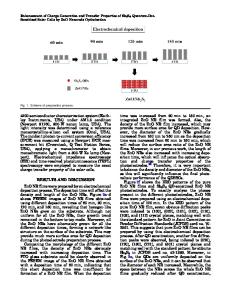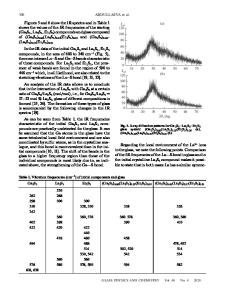Band energy modulation on Cu-doped Sb 2 S 3 -based photoelectrodes for charge generation and transfer property of quantu
- PDF / 1,407,226 Bytes
- 9 Pages / 547.087 x 737.008 pts Page_size
- 74 Downloads / 311 Views
RESEARCH PAPER
Band energy modulation on Cu-doped Sb2S3-based photoelectrodes for charge generation and transfer property of quantum dot–sensitized solar cells Zheng Sun & Zhuoyin Peng & Zhou Liu & Jianlin Chen & Wei Li & Wei Qiu & Jian Chen
Received: 12 April 2020 / Accepted: 2 September 2020 # Springer Nature B.V. 2020
Abstract Sb2S3 quantum dot is prepared as the optical absorber on the ZnO nanorod films to fabricate highefficiency quantum dot–sensitized solar cells. The band energy of the solar cells is modulated by the different concentration of Cu-doping. Meanwhile, the optical absorption spectra and photoluminescence spectra of different ZnO/Sb2S3 photoelectrodes are investigated, which had exhibited the enhancement on optical absorption property and charge separation property by Cudoping process. The charge transfer properties of the solar cells had also been enhanced by the modulation on band energy structure by different Cu-doping concentration. With the relatively larger optical absorption edge, the 0.3 mM Cu–doped ZnO/Sb2S3 quantum dot– sensitized solar cells have exhibited optimal band energy structure for charge transfer, which can obtain higher current density to enhance the photovoltaic power conversion efficiency from 2.55 to 3.14%.
Keywords ZnO/Sb2S3 quantum dot–sensitized solar cells . Cu-doping . Band energy . Charge generation and transfer property . Photovoltaic conversion efficiency Z. Sun : Z. Peng (*) : Z. Liu : J. Chen : W. Li : W. Qiu : J. Chen Key Laboratory of Efficient & Clean Energy Utilization, The Education Department of Hunan Province, Hunan Province 2011 Collaborative Innovation Center of Clean Energy and Smart Grid, School of Energy and Power Engineering, Changsha University of Science and Technology, Changsha 410111, People’s Republic of China e-mail: [email protected]
Introduction Semiconductor quantum dots (QDs) have the advantages of low cost, easy preparation, high stability, size effect, ultrafast electron transfer, and multiple excitons generation, etc. which had been investigated for the applications on the optical and electronic devices (Tang et al. 2019; Wang et al. 2020; Wang et al. 2019a; Chang et al. 2019). Due to its unique optical and electronic properties, many kinds of QDs such as CdX (X = S, Se, Te), PbS (X = S, Se), CuAB2 (A = In, Sb, Ag, B=S, Se) have been prepared as the absorber materials of the quantum dot–sensitized solar cells (QDSSCs), which have achieved excellent photovoltaic conversion efficiency of the solar cells (Singh et al. 2019; Zhang et al. 2019; Wang et al. 2019b; Yang et al. 2019; Lee et al. 2019; Du et al. 2019). Comparing ternary QDs, the binary QDs are easy to be prepared, which can be also obtained the pure crystal structure of the QDs. However, toxic Cd- and Pb-based QDs may induce the environmental pollution in future industry. The deposition content of QDs for the solar cells is still not enough to achieve the best optical absorption property. Moreover, the rate of charge transfer in QDSSCs also needs to be improved. Therefor
Data Loading...











